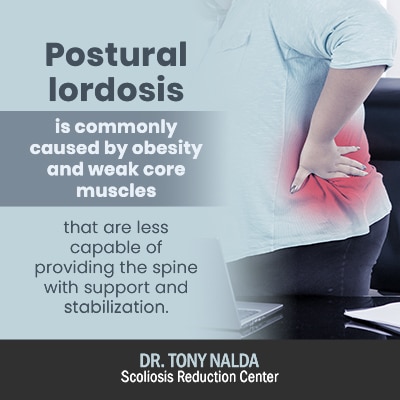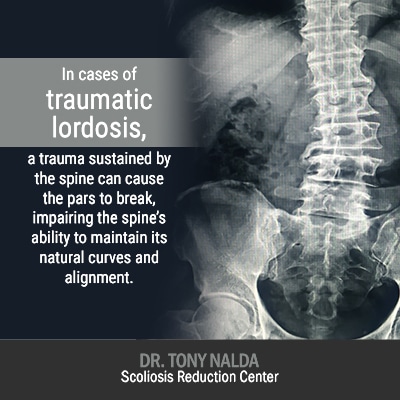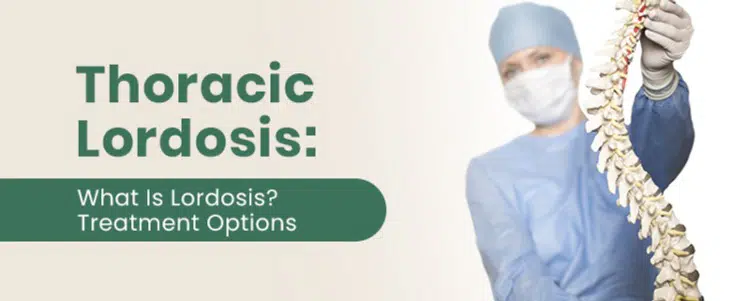In a healthy spine, its three main sections have characteristic curvature types that fall within a normal size range; however, when a spinal curve falls beyond that healthy range, problems can occur. Spinal conditions such as scoliosis, kyphosis, and lordosis involve a loss of the spine’s natural curves, also known as spine curves. Keep reading to find out more about lordosis and related treatment options.
The spine’s optimal function and health depend upon its ability to maintain its natural and healthy curvatures/alignment. Thoracic lordosis is a spinal condition that involves the middle/upper back having an excessive inward curvature, giving the body a swayback appearance.
4 Key Takeaways of Spine Curves
- Understanding Lordosis: Lordosis, particularly thoracic lordosis, involves an excessive inward curvature of the spine, affecting its function and appearance. Proper spinal health relies on maintaining natural curvatures within a specific range to support strength, flexibility, and stress distribution.
- Identifying Types and Causes: Thoracic lordosis can stem from various factors, including postural habits, congenital conditions, surgeries, neuromuscular disorders, or hip flexion contractures. Identifying the underlying cause is crucial for effective treatment.
- Treatment Strategies: Treatment for thoracic lordosis varies depending on its cause. Options may include weight management, strengthening core muscles, specialized chiropractic care, physical therapy, and in severe structural cases, corrective bracing to restore natural curvatures.
- Comprehensive Care Approach: A proactive, integrative treatment approach, combining multiple disciplines such as specific chiropractic adjustments and tailored exercises, offers the best chance for reducing curvature and addressing symptoms like pain and mobility issues associated with thoracic lordosis.
Before we start exploring the specifics of thoracic lordosis, let’s first touch on some basic spinal anatomy for a better overall understanding of spinal health and function.
Basic Cervical Spine Anatomy
The spine has three main sections, each with its own curvature type: kyphosis and lordosis. The spine curves, including kyphotic and lordotic curves, play an essential role in posture, function, and overall health.
Kyphosis refers to curvatures that bend outwards, away from the body’s center, and lordosis refers to curvatures that bend inwards, towards the body’s center.
In a healthy spine, the cervical spine (neck) features a lordotic curve of 20 to 40 degrees. The thoracic spine (middle/upper back) also features a healthy lordotic range of 20 to 40 degrees, and the lumbar spine (lower back) has a natural lordosis that falls in the 40- to 60-degree range.
As you can see, people have their own unique spinal-curvature sizes. As long as they fall within a healthy size range, the spine can maintain those healthy curves and alignment, but problems can occur when a curvature falls beyond a healthy range.
The spine is naturally curved because it gives it added strength, flexibility and helps it to evenly distribute and absorb mechanical stress that’s incurred during movement.
When one or more of the spine’s healthy curves are lost, the spine responds by putting in bad curves, and this disrupts the biomechanics of the entire spine as it’s no longer in a straight and neutral alignment.
So now that we have talked about the spine’s main sections and curvature types, plus healthy vs unhealthy curvature-degree ranges, let’s move on to discussing the specifics of thoracic lordosis.
What is Thoracic Spine Lordosis?
Kyphosis and lordosis are terms that refer both to the spine’s healthy kyphotic and lordotic curves and to when those curves become over-exaggerated, also referred to as hyperkyphosis and hyperlordosis.
While lordosis most commonly affects the lower back and neck as lumbar and cervical lordosis, it can also develop along the lower middle section of the spine as thoracic lordosis or thoracolumbar lordosis.
So when a person develops an excessive inward (lordotic) curvature of the thoracic spine, a diagnosis of thoracic lordosis could be forthcoming. Understanding the type of lordosis diagnosed is crucial for developing an effective treatment plan.
While every case is different based on important patient and condition characteristics such as age, condition type, severity, and curvature location, common symptoms of lordosis include:
- The body having a swayback appearance with buttocks more pronounced and abdomen thrust forward
- When lying flat on the floor, there is a noticeable gap between the floor and spine
- Back pain
- Nerve issues
When it comes to treatment options for lordosis, different condition types will have different treatment needs.
The Main Types of Lordosis
There are 5 primary types of lordosis: postural, congenital/traumatic, post-surgical, neuromuscular, and lordosis related to hip flexion contracture. Accurate diagnosis of the type of lordosis diagnosed is essential for effective treatment.
In order to effectively treat a condition and not just its symptoms, its underlying cause needs to drive the design of treatment plans.
Postural Lordosis

Postural lordosis is commonly caused by obesity and weak core muscles that are less capable of providing the spine with support and stabilization.
When a person carries excess weight in the stomach area, it can pull the back forwards, and when the muscles of the stomach and back are weak, they can’t provide the spine with support, and the pull from the excess weight can cause the spine to curve unnaturally forward (towards the body’s center).
When it comes to treating postural lordosis, the issue of obesity needs to be addressed, along with improving core strength, so the spine is optimally supported/stabilized.
Congenital/Traumatic Lordosis
The vertebrae (bones of the spine) are connected by links called pars, and in cases of congenital lordosis, infants are born with the condition due to a defect in the way these links developed in utero.
In cases of traumatic lordosis, a trauma sustained by the spine can cause the pars to break, impairing the spine’s ability to maintain its natural curves and alignment. Injuries from sports fall or car accidents are common causes of traumatic lordosis.
Whether a break in bone connection was caused by weakened pars due to bone malformations that occurred in utero or a sports injury or trauma, the treatment needs are rest and restricted movement to heal.
If proper healing and movement restriction doesn’t occur, the spine’s vertebrae can slip forward and pinch spinal nerves over time.
Pinched spinal nerves can cause various issues, including pain, numbness, tingling and/or weakness, and dysfunction of the legs.
In addition, once rest and restricted movement have facilitated the healing process, treatment needs include impacting the condition on a structural level, as cases of congenital and traumatic lordosis involve a structural abnormality within the spine itself.
Impacting conditions on a structural level can be done through condition-specific chiropractic care and corrective bracing.
Post-Surgical Hyperlordosis
Most cases of post-surgical hyperlordosis involve a laminectomy where parts of the vertebrae are removed to open up access to the spinal cord and/or nerve roots.
When this is done in multiple areas of the spine, it can lead to the spine becoming unstable and developing a hyperlordotic curve.
This condition type is most prevalent in children who have had surgery to remove spinal cord tumors.
In these types of cases, effective treatment can involve restoring as much of the spine’s healthy curves as possible by increasing core strength for better spinal support/stabilization, condition-specific chiropractic care to try and adjust the most-tilted vertebrae back into alignment with the rest of the spine, and corrective bracing to help work towards corrective results.
Neuromuscular Lordosis
In cases of neuromuscular lordosis, lordosis develops as a secondary complication of a more serious neuromuscular condition.
There are several neuromuscular conditions that can lead to the development of lordosis, but common ones include muscular dystrophy, cerebral palsy, and spina bifida.
In neuromuscular lordosis, there is a disconnect between the brain, the muscles, and/or connective tissues surrounding the spine, which can lead to the spine’s inability to support and stabilize itself.
In cases of neuromuscular lordosis, the underlying neuromuscular condition has to be the guiding force of treatment as it’s at the root of the condition’s causation.
Hip Flexion Contracture-Related Lordosis

This is a unique condition type that occurs when the connective tissues in the hip joints, which are typically elastic, are replaced by inflexible fiber-like tissues.
The stiffness of the hip’s connective tissues makes it difficult to stretch the area and impairs normal movement patterns, and this can affect the lower thoracic spine and lead to the development of an unnatural lordotic curve.
Hip flexion contracture can be caused by infection, injury, muscle imbalances, or the presence of another condition.
In these types of cases, once again, the underlying cause will guide the treatment approach. When muscle imbalances are a contributing factor, a variety of physical therapy exercises and stretches can help increase core strength and keep the spine and its surrounding muscles as loose and flexible as possible.
So as you can see, when it comes to discussing treatment options for thoracic lordosis, the type and effectiveness of treatment will depend on the type of lordosis in question.
There are a number of spinal conditions a person can develop that result in a loss of its healthy curvatures and alignment, and the spine’s natural curvatures are an important part of maintaining optimal spinal health and function.
Lordosis refers to spinal curvatures that bend inwards, towards the body’s center, and when a lordotic curve becomes over-pronounced, exceeding the natural range of 20 to 40 degrees, this can also be referred to as hyperlordosis.
While lordosis most commonly affects the cervical and lumbar spine, it can also develop along the thoracic spine, most commonly the thoracolumbar section, and this can cause the buttocks and abdomen to protrude more, giving the body a swayback appearance, which is why the condition is sometimes called swayback.
Symptoms of thoracic lordosis vary but can include postural changes, pain, and mobility issues.
When a condition is postural, it can be treated by addressing the issues that contributed to its development, such as obesity and related chronic poor posture.
When conditions are structural, they need to be impacted on a structural level to be treated effectively.
, I believe in proactive treatment delivered through a conservative chiropractic-centered approach. While my focus is on scoliosis, I have the training, experience, and knowledge to treat a wide range of spinal conditions such as thoracic lordosis.
By integrating different treatment disciplines such as lordosis-specific chiropractic care, in-office therapy, custom-prescribed home exercises, and corrective bracing, I address a condition’s underlying cause and work towards impacting it on multiple levels for the best results.
Symptoms and Diagnosis
Thoracic lordosis can manifest in various ways, and its symptoms may vary depending on the severity of the condition. Common symptoms include:
- A visible curvature of the upper back, which can give the appearance of a swayback or hunchback
- Postural changes, such as a forward head posture or rounded shoulders
- Pain or discomfort in the upper back, shoulders, or chest
- Difficulty breathing or shortness of breath
- Fatigue or weakness in the muscles of the upper back
Diagnosing thoracic lordosis typically involves a combination of physical examination, medical history, and imaging tests. A healthcare professional may perform the following:
- Visual Examination: The spine is visually assessed for curvature and alignment.
- Palpation: The spine is palpated to check for any abnormalities or tenderness.
- Range of Motion Tests: These tests evaluate the flexibility and mobility of the spine.
- Imaging Tests: X-rays, CT scans, or MRI scans are used to visualize the spine and its surrounding structures, providing a detailed view of the curvature and any associated abnormalities.
Causes and Risk Factors
Thoracic lordosis can be caused by a variety of factors, including:
- Genetics: Some individuals may have a genetic predisposition to develop thoracic lordosis.
- Poor Posture: Chronic poor posture can lead to the development of thoracic lordosis over time.
- Muscle Imbalances: Weak or tight muscles in the upper back can contribute to the development of thoracic lordosis.
- Spinal Cord Tumors: Tumors that develop in the spinal cord can cause thoracic lordosis by compressing or damaging the surrounding spinal tissues.
- Hip Flexion Contracture: A condition in which the connective tissues in the hip joint become shortened, leading to a forward curvature of the upper back.
- Congenital Conditions: Certain congenital conditions, such as spina bifida or scoliosis, can increase the risk of developing thoracic lordosis.
Understanding these causes and risk factors is crucial for both prevention and treatment, as addressing the underlying issues can help manage and mitigate the condition.
Living with Lordosis
Living with thoracic lordosis can present several challenges, including:
- Chronic Pain or Discomfort: Persistent pain or discomfort in the upper back, shoulders, or chest is common.
- Limited Mobility: The curvature of the spine can limit flexibility and mobility, making it difficult to perform everyday activities.
- Breathing Difficulties: In severe cases, thoracic lordosis can compress the lungs and diaphragm, leading to breathing difficulties.
- Emotional Distress: The visible curvature of the spine can cause emotional distress and self-consciousness.
However, with proper treatment and management, it is possible to alleviate symptoms and improve quality of life. Engaging in regular physical therapy, maintaining good posture, and following a comprehensive treatment plan can make a significant difference.
Treatment Options for Thoracic Lordosis
Treatment for thoracic lordosis depends on the severity of the condition and the underlying cause. The following treatment options may be recommended:
- Physical Therapy: A physical therapist can help improve flexibility, strength, and mobility through exercises and stretches tailored to the individual’s needs.
- Bracing: A back brace can help support the spine and improve posture, particularly in growing children or adolescents.
- Surgery: In severe cases, surgery may be necessary to correct the curvature of the spine or relieve compression on the spinal cord.
- Pain Management: Medications or alternative therapies, such as acupuncture or massage, can help manage chronic pain or discomfort.
- Lifestyle Modifications: Maintaining good posture, engaging in regular exercise, and managing weight can help alleviate symptoms and prevent the progression of the condition.
It’s essential to consult with a healthcare professional to determine the best course of treatment for thoracic lordosis. A comprehensive, individualized approach can help manage the condition effectively and improve overall quality of life.
Here at the Scoliosis Reduction Center®, I believe in proactive treatment delivered through a conservative chiropractic-centered approach. While my focus is on scoliosis, I have the training, experience, and knowledge to treat a wide range of spinal conditions such as thoracic lordosis.
By integrating different treatment disciplines such as lordosis-specific chiropractic care, in-office therapy, custom-prescribed home exercises, and corrective bracing, I address a condition’s underlying cause and work towards impacting it on multiple levels for the best results.





